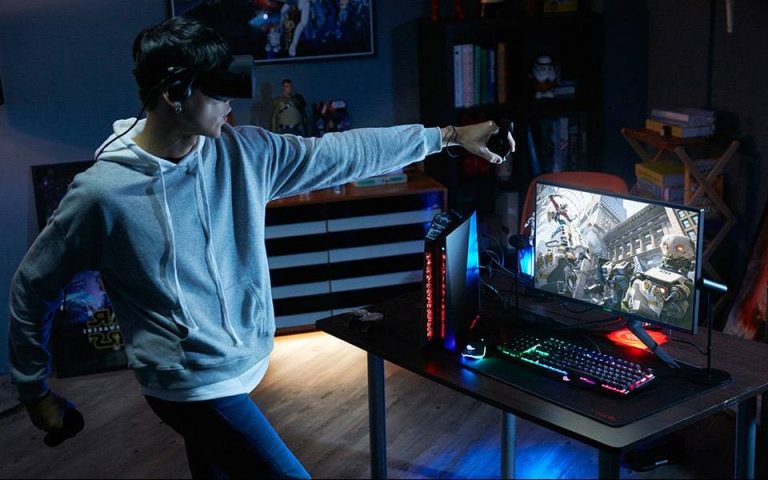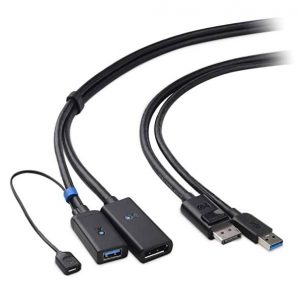When buying a new VR headset (for VR porn or gaming) one has 2 options. You buy a headset that works without a computer or one that needs to be connected to the computer. There are some options in between, but we'll get to that later.
So basically you have to ask yourself what you want to do with your VR headset.
In short, the situation usually is:
“Do I want to be mobile, take my headset with me to another room and be able to turn it on and get going.”
Or:
“I usually sit behind a desk anyway and don't need to move around with my headset. And you like to play graphically intense VR games.”

Obviously if you want to be mobile then you're going to want to buy a wireless set.
There are some great options out there. But no wires comes with some consequences.
If you're using a stand alone headset then the headset basically is your computer. And not much computer fits in your goggles obviously. So this results in a less powerful system than your desktop PC or even your laptop.
For the average user who picks up his goggles every now and then to play a few games or watch a few movies this is fine.
But the die hard VR user might want to opt for a VR headset that connects to your PC. That way your PC takes care of the processing and your headset is basically just a screen that displays what your PC is sending over.
But you w ill have to keep in mind you're stuck to 1 or more cables.
ill have to keep in mind you're stuck to 1 or more cables.
The first generation VR headsets like the HTC Vive(>review)came with a huge bundle of heavy cables. Luckily they changed those for a smaller bunch of cables later. But still, it's something you'll never really get used to.
It also limits your freedom of movement. But it's not the same for every set. Some let you have a play space and others require you to stay behind the desk.
>Take a look at our review section if you want to know more about a specific headset
As the VR technology gets better, we're seeing options like the Oculus Quest 2 which offer best of both worlds.
The Quest 2 works very nicely as a stand alone headset. So you can use it anywhere at any time. But if you want to run some heavy graphics games, or maybe design work or watch the highest resolution VR PORN movies without hiccups.
>Watch our page on 8K VR porn!
then you can connect it with just 1 cable to your PC! This is a light weight cable that can be quite long if you want. So you could actually still move around the room while connected to your PC!
It also lets you transfer files between your VR goggles and PC. And if you have a fast LAN connection it's probably faster to download big movies or games to your PC than to your Quest 2.
>For a full review on the Quest 2 click here
So if you plan on connecting your headset to your computer and want to get the most of it, here's a quick FAQ!
The most popular option at the moment is the Oculus Quest 2. >Read our Quest 2 review here
The 2nd best popular option is the older but still awesome Valve Index. >Read our Valve Index review here
Another great, new headset to connect to your PC or laptop is the HP Reverb G2 >Read our Reverb G2 review here
There is no specific PC that is recommended for virtual reality use. Here you are looking mainly at the specifications in the PC. Firstly it is important to start looking at what VR glasses you want to use. For example, some glasses need a more powerful video card than others. For VR use, the video card (GPU) and the processor (CPU) are particularly important. These ensure that you can play the virtual reality application or game in a smooth manner.
The best VR PC is one with powerful graphics card (minimum GTX 1060, but preferably higher) and a fast processor (minimum Intel Core i5) and 8 GIGS or ram. Though you might get away with lower specs, depending on the app you run. In general, the prettier the graphics, the beefier computer you will need!
We recommend at least a GTX 1060 video card if you want to connect VR glasses to your PC. But in general, the more powerful the video card, the better the performance. Most newer generation cards will do. But we won't recommend going lower than a GTX 980.
We recommend at least an Intel Core i5 processor if you want to connect a VR headset to your PC. Are you planning on doing other things on the PC besides using the VR goggles – and do you want to do this at the same time? Then you might want to opt for an even better processor, such as the Intel Core i7. But don't go lower than a good I5 processor.
Yes, this is certainly possible! Again, make sure you have a powerful video card and a good PC so you have no problems with the smooth playback of VR games. With laptops, it is especially important to check if the laptop has enough connections to connect the VR glasses. In some cases, for example, a laptop does not have a DisplayPort connection, so you need an extra adapter to connect the glasses. Keep in mind that in general laptops are less powerful than a good desktop PC. Especially when it comes to the videocard. Make sure you pick the right laptop if you want to use it for VR!
In some cases you can, but we do not recommend this. The Mac does not have the right connections and software to reliably play virtual reality. There are several solutions for this but that requires a different guide, which we will write in the future.
No, for VR you need at least a Windows 10 operating system (OS). With MacOS it is possible but you will to make quite some adjustments to get your VR headset going. It's not plug & play with most VR goggles!